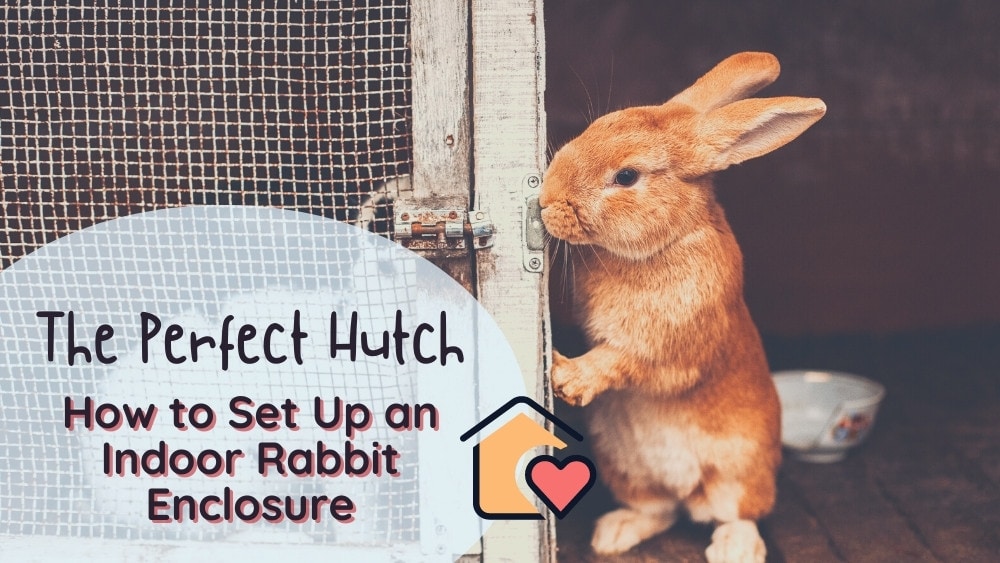Rabbits are intelligent, active animals and need plenty of space to live a happy life. Keeping your bunnies indoors is a great choice. It protects them from severe weather and predators, and promotes more interaction with you!
There are lots of options for keeping your rabbit inside. You might allow them to free-roam or prefer to keep them in an enclosure.
This article will guide you through all you need to know about indoor rabbit enclosure setup.
How to Set Up an Indoor Rabbit Enclosure
First, you need to choose the type of enclosure you will use. Place it in a quiet area, so your rabbit isn’t disturbed.
The enclosure should have plenty of room for your rabbit to move around. You should include essentials like a litter box, a hay rack, toys, and bowls for food and water.
Things Rabbits Need in Their Cage
Picking The Right Enclosure
The first step is to choose the right enclosure for your rabbit. Many new rabbit owners are surprised by just how much space a bunny needs to live happily. They should be able to stretch out fully, stand up on their hind legs, and hop about comfortably.
As a general rule, the bigger the enclosure, the better. The minimum measurements of any rabbit enclosure should be 3m x 2m x 1m (10ft x 6ft x 3ft), but I recommend much more than this. You will need more space if you have a large breed of rabbit or more than one rabbit.
Cage or Hutch
You can buy a cage or hutch from pet shops. However, most pet shop cages and hutches are actually far from big enough. If you choose this option, ensure you check the measurements carefully.
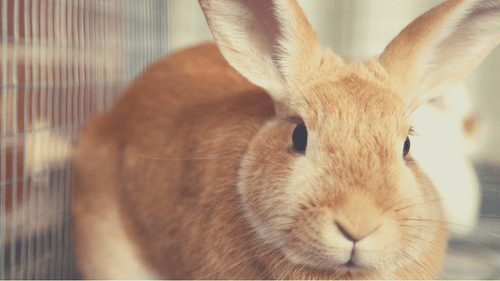
If you’re considering an indoor rabbit cage setup, your rabbit should have a few hours of exercise time out of their enclosure daily. Ideally, you would attach an exercise run to the cage or hutch to increase the space available for your furbaby.
Pet Pen
I recommend using a dog or pet pen as they come in a wide range of sizes, so you can find one that’s big enough for your bunny. You can even attach a couple together to create more space!
They’re easy to set up, affordable, and easy to move around if needed. We used a dog pen for our rabbit and found it worked very well.
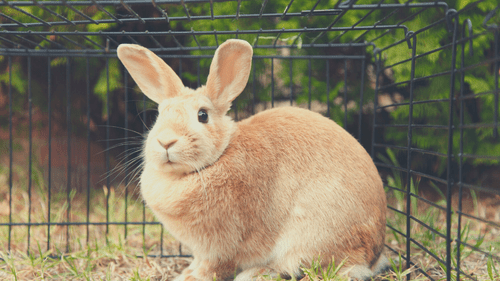
DIY Enclosure
If you’re good with DIY, you can create your own bunny enclosure. Some owners use storage cubes or even repurposed furniture. However, you create your rabbit’s new home, ensure there are no sharp edges or anything harmful they can get their little mouths on.
Make sure it’s secure so that your rabbit can’t escape and get themselves into mischief.
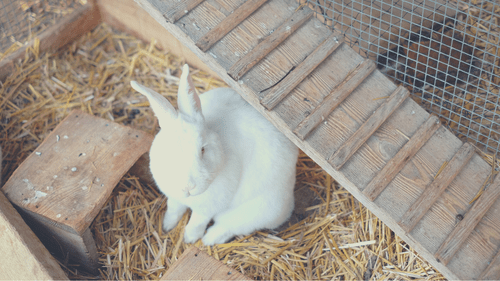
A Rabbit Room
Another option is dedicating an entire room or part of a room to your bunny. Using part of a room with a pet pen to create a barrier can be very effective.
It’s crucial that you bunny-proof the room to make sure your rabbit is safe. Block off any wires, plug sockets, or other items they could hurt themselves on.
Free Roaming
Some people let their rabbits free roam, which is a fantastic choice! This means their rabbits have access to most or all of the home. If you choose to do this, you won’t need to set up an enclosure.
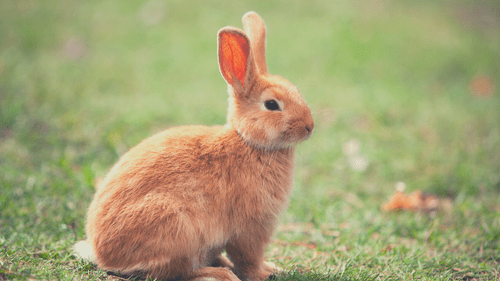
Of course, you’ll still need to provide the other supplies we’ll discuss below. You will also need to bunny-proof your home carefully to keep your rabbit and your belongings safe.
Other Supplies
Before you set up your rabbit’s new enclosure, you’ll need to gather some supplies for the inside of their enclosure.
Litter Box
Litter training your rabbit helps to keep their home clean and makes things easier for you. Choose a litter box that’s big enough for your rabbit to sit in comfortably.
Some corner litter boxes marketed towards rabbit owners can be a bit small, depending on your rabbit’s breed. A good alternative is a cat litter tray with no lid or a removable lid.
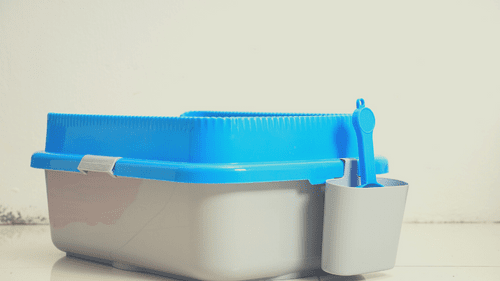
If you have two or more rabbits, it’s best to provide a litter tray per rabbit to prevent them from fighting over resources.
You’ll also want litter to go in the litter box. Paper-based litter is best as it’s non-toxic to rabbits. Avoid clumping litter or litter made from pine or cedar shavings, as these aren’t safe for bunnies.
Hay Rack and Hay
There is a huge range of hay feeders for rabbits, including metal, plastic, wooden, and wicker hay racks! You’ll see racks you can attach to the side of the cage, ones that hang from the roof, and free-standing racks.
As long as the rack is bunny-safe and big enough to hold a decent amount of hay, it should work just fine! It’s up to you what you feel is best for your bunny.
If you have more than one rabbit, get a hay rack per bunny to reduce the risk of squabbles. You can also choose to simply scatter the hay on the ground. However, many owners (myself included) find this less hygienic and harder to clean up.
You’ll need quality hay to put in your hay rack. Your rabbit’s diet should be 85% hay or grass.
Timothy hay is widely available and suitable for your bunny. You can also feed a range of other hays, but always check they’re suitable for rabbits.
Shelter
Rabbits are prey animals, so they do better when they have some shelter to make them feel safe. You can buy rabbit shelters or make them yourself. Even a cardboard box works!
You can use anything on hand if the shelter is big enough for your bunny to get inside and is safe. If you have more than one rabbit, provide one shelter per bunny.
Food and Water
You can buy bowls for your rabbit’s food and water from pet shops. Heavy bowls are best, as they stop your rabbit from flipping them over and making a mess. If they’re anything like my bunny was, this will be a frequent occurrence without the right bowl!
When it comes to water, you can choose either a bowl or a bottle. Bowls are a more natural way of drinking for a rabbit, but bottles are often more hygienic. Both have pros and cons, so do your research before making your choice. You should offer a food bowl and water bowl or bottle per rabbit.
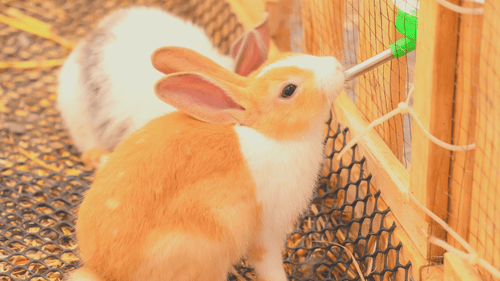
Toys
Rabbits are highly intelligent animals, and they need lots of mental stimulation. Providing toys helps to prevent boredom when you aren’t interacting with them.
There are lots of toys available, from chew toys to puzzle toys. Take your time to research and pick a few options to get started.
Flooring
Depending on the type of enclosure you choose, you might want to get some flooring to make your rabbit more comfortable or protect the floors in your home. This doesn’t have to be expensive. You could use an old rug, mats, or carpet runners.
What You Need: A Summary
Below is a simple list to help you ensure you’ve got all the supplies you need:
- Your choice of enclosure
- Litter box
- Litter
- Hay Rack
- Hay
- Shelter
- Food bowls
- Water bowls or bottles
- Range of toys
- Flooring
Indoor Rabbit Enclosure Setup: Step by Step
Now that you’ve gathered your supplies, you’re ready to set up your enclosure. The steps below will guide you.
1. Choosing The Right Spot
The first thing to do is choose a safe spot for your bunny’s enclosure. For example, you want to keep them away from wires or poisonous plants.
Choose an area of your home where there’s not too much noise. You’ll want to find a balance between them not being shut away from the rest of the family and having a quiet place to relax.
Ideally, their enclosure shouldn’t be in an area that people will be walking past regularly, as this will be stressful for them.
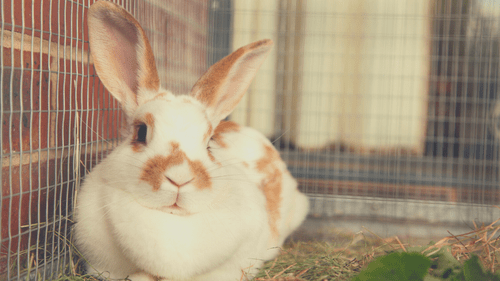
You should place their enclosure away from other pets. It should be away from young children and any other stress factors. Think of it like your bunny’s own little sanctuary.
Rabbits need to be in a room where they get some natural light. However, their enclosure shouldn’t be in direct sunlight, which can be too hot for them. They should also be away from radiators or other direct heat sources, as they can get overheated easily.
If your rabbit isn’t free roaming, they need to get out of their enclosure regularly for exercise. It’s best to choose a spot where you can open the enclosure’s gate and let them run free safely.
Once you’ve chosen your spot, assemble your enclosure for your bunny!
2. Setting Up Flooring
If the floor of the enclosure is slippy or hard, set up some soft flooring. This prevents your bunny from slipping around and keeps their feet comfortable.
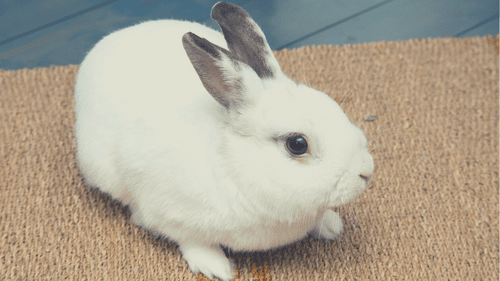
If the enclosure floor is your carpet, you may want to cover it over with something like an old rug to protect it.
3. Placing The Shelters
Put your chosen shelters in the corner of your rabbit’s enclosure. The idea is to create a safe place where your rabbit can rest or hide if they feel scared. Face the door to the shelter away from the front of the enclosure, so they have as much privacy as possible.
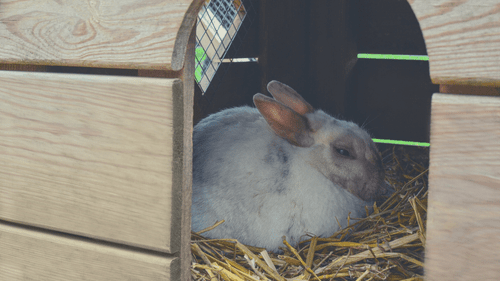
If your rabbit is mischievous like mine was, you’ll want to place the shelter against a back wall of the enclosure. This prevents them from hopping on top of the shelter and using it to escape.
4. Setting Up The Litter Box
Now it’s time to add the litter box. Place it in one corner of the enclosure. You can always move to another corner later if you notice your rabbit is going to the toilet elsewhere.
Fill the bottom of the tray with your chosen litter. You only need a thin layer, as rabbits don’t bury their poop.
5. Setting Up The Hay Rack
It’s best to put the hay rack near the litter box. Rabbits like to munch on hay while they go to the toilet.
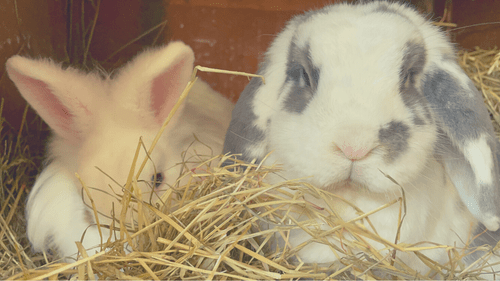
Ensure it’s high enough that your rabbit doesn’t have to lower their neck to reach it but not so high up that they have to stand on their back legs. Fill it up with your chosen hay, and you’re ready to go!
6. Food and Water
Next, you can add their food bowl and water bowl or bottle. Place them as far away from the litter tray as possible to keep things hygienic.
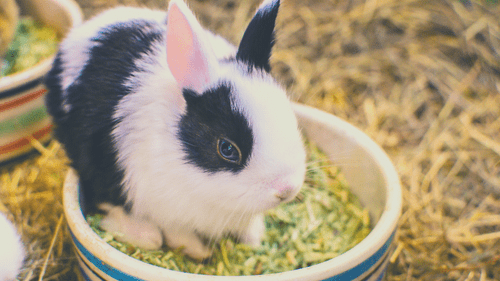
If you’re using a bottle, make sure it’s at a comfortable height for your bunny to access without bending or stretching. Add in their pellets and water, and you’re all set.
7. Add Toys
Gather your chosen toys and add them to your rabbit’s enclosure. It’s a good idea to have a few different toys scattered around.
Toys keep your rabbit busy and stop them from getting bored.
8. Introduce Your Bunny
Finally, you’re ready to introduce your rabbit to its new home! When you first put them into the enclosure, give them some time to themselves to explore.
If you find that they prefer their ‘furniture’ in different areas, you can always move things around later. You might find they rearrange things themselves!
Conclusion
The right enclosure is key to your rabbit’s health and happiness. They need plenty of space to hop around and lots of things to explore. With the right set-up, you and your bunny can live a happy life together.
Did you find this tutorial helpful? What type of enclosure do you use for your rabbits?


